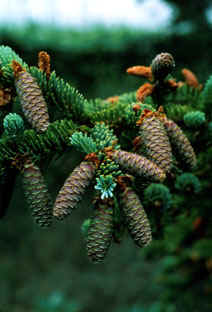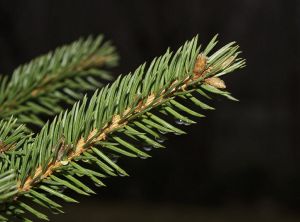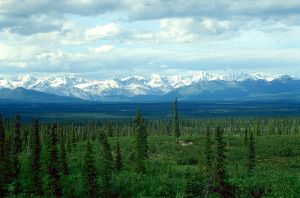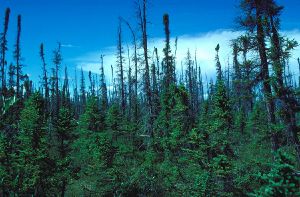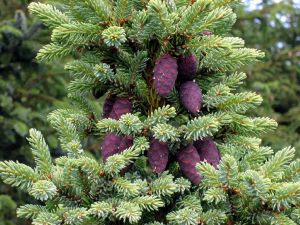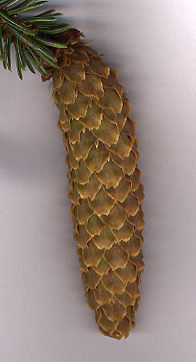Difference between revisions of "Spruce" - New World Encyclopedia
({{Contracted}}) |
Rick Swarts (talk | contribs) |
||
| Line 1: | Line 1: | ||
{{Claimed}}{{Contracted}} | {{Claimed}}{{Contracted}} | ||
| + | |||
| + | {{Taxobox | ||
| + | | color = lightgreen | ||
| + | | name = Spruce | ||
| + | | image = Picea abies.jpg | ||
| + | | image_width = 240px | ||
| + | | image_caption = [[Norway Spruce]] (''Picea abies'') | ||
| + | | regnum = [[Plant]]ae | ||
| + | | divisio = [[Pinophyta]] | ||
| + | | classis = [[Pinophyta|Pinopsida]] | ||
| + | | ordo = [[Pinales]] | ||
| + | | familia = [[Pinaceae]] | ||
| + | | genus = '''''Picea''''' | ||
| + | | genus_authority = [[Johann Heinrich Friedrich Link|Link]] | ||
| + | | subdivision_ranks = Species | ||
| + | | subdivision = About 35; see text. | ||
| + | }} | ||
| + | [[Image:Picea_glauca1.jpg|right|thumb|Foliage and cones of [[White Spruce]]]] | ||
| + | [[Image:Pinetrees.JPG|thumb|right|Norway Spruce foliage]] | ||
| + | [[Image:Picea glauca taiga.jpg|thumb|right|White Spruce taiga, Denali Highway, Alaska Range, Alaska.]] | ||
| + | [[Image:Picea mariana taiga.jpg|thumb|right|[[Black Spruce]] taiga, Copper River, Alaska.]] | ||
| + | [[Image:Picea mariana cones.jpg|right|thumb|Black Spruce foliage and cones]] | ||
| + | [[Image:Picea sitchensis2.jpg|right|thumb|[[Sitka Spruce]] cone]] | ||
| + | |||
| + | '''Spruce''' is the common name for any of the various [[conifer|coniferous]] [[tree#Deciduous versus evergreen|evergreen]] [[tree]]s or [[shrub]]s comprising the the genus '''''Picea''''' of the family [[Pinaceae]], characterized by | ||
| + | |||
| + | |||
| + | |||
| + | found in the northern [[temperate]] and [[boreal]] ([[taiga]]) regions of the earth. Spruces are large trees, from 20–60 (–95) m tall when mature, and can be distinguished by their [[whorl]]ed branches and [[cone (geometry)|conical]] form. The needles, or leaves, of spruce trees are attached singly to the branches in a spiral fashion, each needle on a small peg-like structure called a ''pulvinus''. The needles are shed when 4–10 years old, leaving the branches rough with the retained pulvini (an easy means of distinguishing them from other similar genera, where the branches are fairly smooth). | ||
| + | |||
| + | Spruces are used as food plants by the [[larva]]e of some [[Lepidoptera]] species; see [[list of Lepidoptera which feed on Spruces]]. They are also used as food plants by [[Gall Adelgid]]s (''Adelges'' species). | ||
| + | |||
| + | The word "spruce" derives from an obsolete term for [[Prussia]]. | ||
| + | |||
| + | ==Description== | ||
| + | |||
| + | ==Uses== | ||
| + | Spruce is one of the most important woods for [[paper]] manufacture, as it has long wood fibres which bind together to make strong paper. Spruces are cultivated over vast areas for this purpose. | ||
| + | |||
| + | Spruces are also popular ornamental trees in [[horticulture]], admired for their evergreen, symmetrical narrow-conic growth habit. For the same reason, some (particularly ''Picea abies'' and ''P. omorika'') are also extensively used as [[Christmas tree]]s. | ||
| + | |||
| + | Spruce [[wood]], often called ''whitewood'', is used for many purposes, ranging from general construction work and crates to highly specialised uses in wooden aircraft and many musical instruments, including [[guitars]], [[mandolins]], [[cellos]], [[violins]], and the [[Sounding board|soundboard]] at the heart of a [[piano]]. The [[Wright Brothers]] first aircraft was built of spruce. | ||
| + | |||
| + | The [[resin]] was used in the manufacture of [[pitch (resin)|pitch]] in the past (before the use of [[petrochemical]]s); the scientific name ''Picea'' is generally thought to be derived from Latin ''pix'', pitch (though other etymologies have been suggested). | ||
| + | |||
| + | The leaves and branches, or the essential oils, can be used to brew [[spruce beer]]. The tips from the needles can be used to make spruce tip syrup. | ||
| + | |||
| + | [[Indigenous people of the Americas|Native Americans]] in eastern [[North America]] once used the thin, pliable roots of some species for weaving [[basket]]s and for sewing together pieces of [[birch]] bark for [[canoe]]s. See also [[Kiidk'yaas]] for an unusual golden Sitka Spruce sacred to the [[Haida]] people. | ||
| + | |||
| + | In survival situations spruce needles can be directly ingested or boiled into a tea. This replaces large amounts of vitamin C. Water is also stored in a spruces needles providing an alternative means of hydration. Spruce can be used as a preventative measure for scurvy in an environment where meat is the only prominent food source. | ||
| + | |||
| + | Spruce branches are also used at Aintree racecourse, Liverpool, to build several of the fences on the Grand National course. | ||
| + | |||
| + | == Classification == | ||
| + | 1 ''Cones with thickish scales; leaves quadrangular in cross-section'': section '''''Picea''''' | ||
| + | :1a ''Cones with (mostly) pointed scales; leaves blunt or somewhat pointed'' | ||
| + | :* ''[[Picea abies]]'' Norway Spruce. [[Europe]]; important in [[forestry]]. The original [[Christmas tree]]. | ||
| + | :* ''[[Picea asperata]]'' Dragon Spruce. Western [[China]]; several varieties. | ||
| + | :* ''[[Picea meyeri]]'' Meyer's Spruce. Northern [[China]]. | ||
| + | :* ''[[Picea koraiensis]]'' Korean Spruce. [[Korea]], northeast [[China]]. | ||
| + | :* ''[[Picea koyamae]]'' Koyama's Spruce. [[Japan]] (mountains). | ||
| + | |||
| + | :1b ''Cones with smoothly rounded scales; leaves blunt or somewhat pointed'' | ||
| + | :* ''[[Picea orientalis]]'' Caucasian Spruce or Oriental Spruce . [[Caucasus]], northeast [[Turkey]]. | ||
| + | :* ''[[Picea morrisonicola]]'' Yushan Spruce . [[Taiwan]] (high mountains). | ||
| + | :* ''[[Picea wilsonii]]'' Wilson's Spruce . Western [[China]]. | ||
| + | :* ''[[Picea obovata]]'' Siberian Spruce. North [[Scandinavia]], [[Siberia]]. Often treated as a variant of ''P. abies'' (and hybridises with it) but distinct cones. | ||
| + | :* ''[[Picea schrenkiana]]'' Schrenk's Spruce. Mountains of central [[Asia]]. | ||
| + | :* ''[[Picea smithiana]]'' Morinda Spruce. Western [[Himalaya]]. | ||
| + | :* ''[[Picea alpestris]]'' Norway Spruce, Alpine Spruce. The [[Alps]] in [[Europe]]; rare, often treated as a variant of ''P. abies'' (and hybridises with it) distinct cones. | ||
| + | |||
| + | :1c ''Cones with smoothly rounded scales; leaves viciously sharp-pointed'' | ||
| + | :* ''[[Picea maximowiczii]]'' Maximowicz Spruce. [[Japan]] (rare, mountains). | ||
| + | :* ''[[Picea torano]]'' Tiger-tail Spruce. [[Japan]]. | ||
| + | :* ''[[Picea neoveitchii]]'' Veitch's Spruce. Northwest [[China]] (rare, endangered). | ||
| + | :* ''[[Picea martinezii]]'' Martinez Spruce. Northeast [[Mexico]] (very rare, endangered). | ||
| + | :* ''[[Picea chihuahuana]]'' Chihuahua Spruce. Northwest [[Mexico]] (rare). | ||
| + | |||
| + | 2 ''Cones with thickish wavy scales, leaves slightly to strongly flattened'': section '''''Omorika''''' | ||
| + | :2a ''Cones mostly with rounded scales; leaves flattened in section, white below'' | ||
| + | :* ''[[Picea breweriana]]'' Brewer's Spruce. [[Klamath Mountains]], [[North America]]; local [[endemic (ecology)|endemic]]. | ||
| + | :* ''[[Picea brachytyla]]'' Sargent's Spruce. Southwest [[China]]. | ||
| + | :* ''[[Picea farreri]]'' Burmese Spruce. Northeast [[Burma]], southwest [[China]] (mountains). | ||
| + | :* ''[[Picea omorika]]'' Serbian Spruce. [[Serbia]]; local [[endemic (ecology)|endemic]]; important in horticulture. | ||
| + | |||
| + | :2b ''Cones mostly with wavy scales; leaves slightly flattened in section, often paler below'' | ||
| + | :* ''[[Picea mariana]]'' Black Spruce. Northern [[North America]]. | ||
| + | :* ''[[Picea rubens]]'' Red Spruce. Northeastern [[North America]]; important in [[forestry]]. | ||
| + | :* ''[[Picea glehnii]]'' Glehn's Spruce. Northern [[Japan]], [[Sakhalin]]. | ||
| + | :* ''[[Picea alcockiana]]'' ("''P. bicolor''") Alcock's Spruce. Central [[Japan]] (mountains). | ||
| + | :* ''[[Picea purpurea]]'' Purple Spruce. Western [[China]]. | ||
| + | :* ''[[Picea balfouriana]]'' Balfour's Spruce. Western [[China]]. | ||
| + | :* ''[[Picea likiangensis]]'' Likiang Spruce. Southwest [[China]]. | ||
| + | :* ''[[Picea spinulosa]]'' Sikkim Spruce. Eastern [[Himalaya]]. | ||
| + | |||
| + | 3 ''Cones with very thin, wavy scales'': section ''''Casicta'''' | ||
| + | :* ''[[Picea glauca]]'' White Spruce. Northern [[North America]]; important in [[forestry]]. | ||
| + | :* ''[[Picea engelmannii]] ''Engelmann Spruce. Western [[North America|North American]] mountains; important in [[forestry]]. | ||
| + | :* ''[[Picea sitchensis]]'' [[Sitka, Alaska|Sitka]] Spruce. Pacific Coast of [[North America]]; the largest species, to 95m tall; important in [[forestry]]. | ||
| + | :* ''[[Picea jezoensis]]'' Jezo Spruce. Northeast [[Asia]], [[Kamchatka Peninsula|Kamchatka]] south to [[Japan]]. | ||
| + | :* ''[[Picea pungens]]'' Blue Spruce or Colorado Spruce. [[Rocky Mountains]], [[North America]]; important in horticulture. | ||
| + | |||
| + | ==External links== | ||
| + | * [http://www.pinetum.org/cones/PICEAcones.htm Arboretum de Villardebelle Picea cone photos] Cones of selected species (page 1) | ||
| + | * [http://www.pinetum.org/cones/PICEAcones2.htm Arboretum de Villardebelle Picea cone photos] Cones of selected species (page 2) | ||
| + | * [http://www.conifers.org/pi/pic/index.htm Gymnosperm Database - Picea] | ||
| + | {{Commonscat|Picea}} | ||
| + | |||
| + | {{Pinaceae}} | ||
| + | |||
| + | [[Category:Life sciences]] | ||
| + | [[Category:Plants]] | ||
| + | {{credit|Spruce|163187129}} | ||
Revision as of 02:17, 31 October 2007
| Spruce | ||||||||||||
|---|---|---|---|---|---|---|---|---|---|---|---|---|
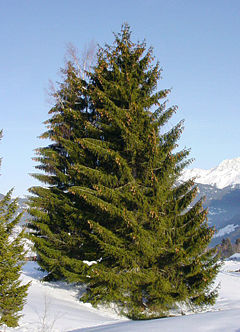 Norway Spruce (Picea abies)
| ||||||||||||
| Scientific classification | ||||||||||||
| ||||||||||||
|
About 35; see text. |
Spruce is the common name for any of the various coniferous evergreen trees or shrubs comprising the the genus Picea of the family Pinaceae, characterized by
found in the northern temperate and boreal (taiga) regions of the earth. Spruces are large trees, from 20–60 (–95) m tall when mature, and can be distinguished by their whorled branches and conical form. The needles, or leaves, of spruce trees are attached singly to the branches in a spiral fashion, each needle on a small peg-like structure called a pulvinus. The needles are shed when 4–10 years old, leaving the branches rough with the retained pulvini (an easy means of distinguishing them from other similar genera, where the branches are fairly smooth).
Spruces are used as food plants by the larvae of some Lepidoptera species; see list of Lepidoptera which feed on Spruces. They are also used as food plants by Gall Adelgids (Adelges species).
The word "spruce" derives from an obsolete term for Prussia.
Description
Uses
Spruce is one of the most important woods for paper manufacture, as it has long wood fibres which bind together to make strong paper. Spruces are cultivated over vast areas for this purpose.
Spruces are also popular ornamental trees in horticulture, admired for their evergreen, symmetrical narrow-conic growth habit. For the same reason, some (particularly Picea abies and P. omorika) are also extensively used as Christmas trees.
Spruce wood, often called whitewood, is used for many purposes, ranging from general construction work and crates to highly specialised uses in wooden aircraft and many musical instruments, including guitars, mandolins, cellos, violins, and the soundboard at the heart of a piano. The Wright Brothers first aircraft was built of spruce.
The resin was used in the manufacture of pitch in the past (before the use of petrochemicals); the scientific name Picea is generally thought to be derived from Latin pix, pitch (though other etymologies have been suggested).
The leaves and branches, or the essential oils, can be used to brew spruce beer. The tips from the needles can be used to make spruce tip syrup.
Native Americans in eastern North America once used the thin, pliable roots of some species for weaving baskets and for sewing together pieces of birch bark for canoes. See also Kiidk'yaas for an unusual golden Sitka Spruce sacred to the Haida people.
In survival situations spruce needles can be directly ingested or boiled into a tea. This replaces large amounts of vitamin C. Water is also stored in a spruces needles providing an alternative means of hydration. Spruce can be used as a preventative measure for scurvy in an environment where meat is the only prominent food source.
Spruce branches are also used at Aintree racecourse, Liverpool, to build several of the fences on the Grand National course.
Classification
1 Cones with thickish scales; leaves quadrangular in cross-section: section Picea
- 1a Cones with (mostly) pointed scales; leaves blunt or somewhat pointed
- Picea abies Norway Spruce. Europe; important in forestry. The original Christmas tree.
- Picea asperata Dragon Spruce. Western China; several varieties.
- Picea meyeri Meyer's Spruce. Northern China.
- Picea koraiensis Korean Spruce. Korea, northeast China.
- Picea koyamae Koyama's Spruce. Japan (mountains).
- 1b Cones with smoothly rounded scales; leaves blunt or somewhat pointed
- Picea orientalis Caucasian Spruce or Oriental Spruce . Caucasus, northeast Turkey.
- Picea morrisonicola Yushan Spruce . Taiwan (high mountains).
- Picea wilsonii Wilson's Spruce . Western China.
- Picea obovata Siberian Spruce. North Scandinavia, Siberia. Often treated as a variant of P. abies (and hybridises with it) but distinct cones.
- Picea schrenkiana Schrenk's Spruce. Mountains of central Asia.
- Picea smithiana Morinda Spruce. Western Himalaya.
- Picea alpestris Norway Spruce, Alpine Spruce. The Alps in Europe; rare, often treated as a variant of P. abies (and hybridises with it) distinct cones.
- 1c Cones with smoothly rounded scales; leaves viciously sharp-pointed
- Picea maximowiczii Maximowicz Spruce. Japan (rare, mountains).
- Picea torano Tiger-tail Spruce. Japan.
- Picea neoveitchii Veitch's Spruce. Northwest China (rare, endangered).
- Picea martinezii Martinez Spruce. Northeast Mexico (very rare, endangered).
- Picea chihuahuana Chihuahua Spruce. Northwest Mexico (rare).
2 Cones with thickish wavy scales, leaves slightly to strongly flattened: section Omorika
- 2a Cones mostly with rounded scales; leaves flattened in section, white below
- 2b Cones mostly with wavy scales; leaves slightly flattened in section, often paler below
- Picea mariana Black Spruce. Northern North America.
- Picea rubens Red Spruce. Northeastern North America; important in forestry.
- Picea glehnii Glehn's Spruce. Northern Japan, Sakhalin.
- Picea alcockiana ("P. bicolor") Alcock's Spruce. Central Japan (mountains).
- Picea purpurea Purple Spruce. Western China.
- Picea balfouriana Balfour's Spruce. Western China.
- Picea likiangensis Likiang Spruce. Southwest China.
- Picea spinulosa Sikkim Spruce. Eastern Himalaya.
3 Cones with very thin, wavy scales: section 'Casicta'
- Picea glauca White Spruce. Northern North America; important in forestry.
- Picea engelmannii Engelmann Spruce. Western North American mountains; important in forestry.
- Picea sitchensis Sitka Spruce. Pacific Coast of North America; the largest species, to 95m tall; important in forestry.
- Picea jezoensis Jezo Spruce. Northeast Asia, Kamchatka south to Japan.
- Picea pungens Blue Spruce or Colorado Spruce. Rocky Mountains, North America; important in horticulture.
External links
- Arboretum de Villardebelle Picea cone photos Cones of selected species (page 1)
- Arboretum de Villardebelle Picea cone photos Cones of selected species (page 2)
- Gymnosperm Database - Picea
| Links to other Pinaceae genera |
| Pinus | Picea | Cathaya | Larix | Pseudotsuga | Abies | Cedrus | Keteleeria | Pseudolarix | Nothotsuga | Tsuga |
Credits
New World Encyclopedia writers and editors rewrote and completed the Wikipedia article in accordance with New World Encyclopedia standards. This article abides by terms of the Creative Commons CC-by-sa 3.0 License (CC-by-sa), which may be used and disseminated with proper attribution. Credit is due under the terms of this license that can reference both the New World Encyclopedia contributors and the selfless volunteer contributors of the Wikimedia Foundation. To cite this article click here for a list of acceptable citing formats.The history of earlier contributions by wikipedians is accessible to researchers here:
The history of this article since it was imported to New World Encyclopedia:
Note: Some restrictions may apply to use of individual images which are separately licensed.
